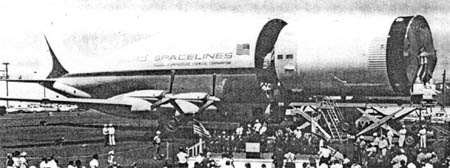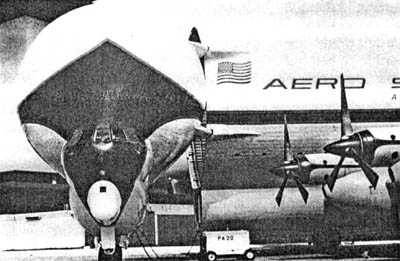| be intelligible. But I remembered the cursing I had given
the radios the day before for not working at all, and now was grateful
just to get through. But just when it seemed we had absolutely nothing
going for us, Lady Luck smiled. The inspection hatches and access doors
blew out in the tail section, and this relieved the immense internal air
pressure that had been threatening to blow the ship apart. The haze of
borate also was whisked away by the rushing air. A spark of "Can we save
her?" began to show among the crew. "Los Angeles Center, this is Thirty-eight
Victor. Request a chase plane for inspection of damage." "Thirty-eight
Victor, this is George Air Force Base Tower at Victorville. I can scramble
a couple of air defense fighters for you." "Roger, George, we'll take
thc fighters." "Thirty-eight Victor, this is Edwards Air Force Base Tower.
We have a DC-9 in flight test on a take-off roll. Can he help you?" |
"Roger, Edwards, we'll take the DC-9. George, from Thirty-eight
Victor, cancel the fighters, and thank you." The Mayday call was made
on an International Distress frequency, which is continuously monitored
by all agencies, and gave us instantly coordinated communications. While
we waited for the DC-9 chase plane to arrive and inspect our damage from
the outside, we again checked the interior damage. We knew the huge Guppy
well, for in addition to twenty-five days of flight tests, we had flown
her on a cross-country tour to display and sell this mammoth cargo-carrying
concept to the National Aeronautics and Space Administration. We had taken
her to the Manned Space Flight Center at Houston, where Astronaut Pete
Conrad had wished us good luck, and we returned the good wish. We had
also shown her off at the Marshall Space Flight Center at Huntsville,
Ala. Administration officials in Washington, D.C., had viewed her at Dulles
International Airport, and top US Air Force |
brass inspected her at Andrews Air Force Base in Maryland.
We had hoped to convince NASA that the Guppy, built by a small California
firm in Van Nuys, could transport the huge Saturn rocket components for
the Apollo moon landing much cheaper and faster than originally estimated.
NASA had planned to ship the giant, twenty-three-and-a-half-foot diameter,
third-stage booster from its Douglas manufacturing plant on the West Coast
by barge through the Panama Canal to Cape Kennedy. Our company calculated
that if an airplane could be designed to accommodate cargo this size,
and if it could pass airworthiness tests, surely both government and space-industry
officials would be highly interested. The tremendous savings in transportation
costs and the elimination of the hazards of a three-week-long ocean voyage
to extremely delicate instruments should be especially attractive. Now
the DC-9 came into view and banked into position off our. |
 A
"shocking disregard for aerodynamic aestetics" allows the modified C-97
to carry this third stage of Saturn IVB, the booster that powers Apollo
moon rockets from earth orbit to lunar orbit.
A
"shocking disregard for aerodynamic aestetics" allows the modified C-97
to carry this third stage of Saturn IVB, the booster that powers Apollo
moon rockets from earth orbit to lunar orbit.